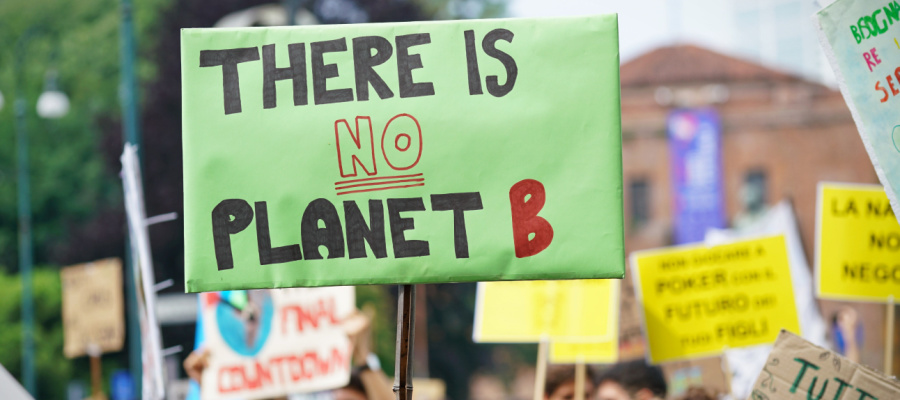The Leap Manifesto is ambitious, but it’s not the end of capitalism
Only “Radical” Next to Parties’ Modest Climate Plans
The Leap Manifesto: A Call for Canada Based on Caring for the Earth and One Another was launched by a group of prominent Canadians on September 15. So far, over 25,000 Canadians have added their names to the declaration. In the face of the ho-hum party platforms on offer, many see the manifesto as a way to give expression to their desire for bold climate action and social justice.
Many mainstream media commentators, however, promptly set their hair on fire.
The Globe and Mail claimed the document calls for “upending of [the] capitalist system.” An editorial appearing in the Vancouver Sun asserted the manifesto was released by “some of this country’s most left-wing and radical forces,” and alarmingly described it as “a chilling document that suggests pushing Canada farther to the left than has ever been imagined for this country. It is ultimately a plan to completely reject capitalism for something kinder and gentler.” In the National Post, the Leap prompted none other than Conrad Black to write an entire op-ed of extended, albeit very creative insults.
You get the gist. But it’s all nonsense.
For the most part, the Leap is merely a pronouncement that policy and politics should align with climate science (heck, even former Bank of Canada governor Mark Carney is saying that), that we should honour the treaties signed with First Nations, and that we should seek to seriously address inequality — hardly far-left field propositions.
True, the Leap is ambitious, but it only seems radical in comparison to the platforms of the major parties. And that’s only because the bandwidth of what is deemed politically acceptable has become so narrow. (Even the Green Party, whose climate plan is mildly more ambitious than the three main parties, has a platform that I’d call more of a hop than a leap.)
But that shouldn’t surprise us. As the Pope writes of the climate crisis in his recent Encyclical:
“It is remarkable how weak international political responses have been… There are too many special interests, and economic interests easily end up trumping the common good and manipulating information so that their own plans will not be affected… Consequently the most one can expect is superficial rhetoric, sporadic acts of philanthropy and perfunctory expressions of concern for the environment, whereas any genuine attempt by groups within society to introduce change is viewed as a nuisance based on romantic illusions or an obstacle to be circumvented.”
Nailed it.
It’s all about infrastructure
In fact, what the Leap calls for is reasonable, affordable, and doable.
Much of what the Leap envisions is a bold infrastructure plan (transit, high speed rail, renewable energy, zero-carbon buildings, etc.). Infrastructure is rightly understood as an investment, and thus it makes sense to amortize the cost over many years.
Moreover, it is already the case that our governments spend billions of dollars a year on infrastructure, but these dollars go towards traditional projects (roads, bridges, and port and energy infrastructure) with the aim of accommodating cars and facilitating the extraction and export of fossil fuels. BC, for example, is slated to spend billions replacing the Massey Tunnel with a new bridge, in part to accommodate more vehicle traffic, but the biggest beneficiaries will likely be industrial users wanting ocean-going ships to be able to get further up the Fraser River to export U.S. thermal coal. What is needed instead is to shift these expenditures from old-economy infrastructure to the green infrastructure we now need.
Let us imagine, however, an ambitious infrastructure and social program plan that sought to boost federal government spending by $50-60 billion a year. That sounds like a lot of money, and indeed it would allow for an exciting set of initiatives that, by any measure, would constitute a “leap” into a new and more caring economy.
But to put that into perspective: in an economy such as Canada’s, with an annual GDP of over $2 trillion, a bold spending and investment plan of $50-60 billion represents about 2.5 per cent of GDP. Put another way, it would mean increasing federal spending from 12.8 per cent of GDP today to about 15.5 per cent. Hardly sounds like “pushing Canada farther to the left than has ever been imagined,” as the Vancouver Sun opines. Exciting, but not a revolution.
And consider this: if one tallies up federal tax cuts over the last 15 years (disproportionately benefiting the wealthy), one finds that these have coincidentally depleted the federal treasury’s capacity to spend and invest by, you guessed it, about $50 billion a year; meaning, if the federal government collected taxes at the same rates that existed in the year 2000, we would have $50 billion more per year to spend on programs to meet our most pressing social and environmental needs (and provincial tax cuts over 20 years have had a similar effect).
What Parties Propose
None of the main parties are proposing climate and infrastructure plans on the order envisioned by the Leap.
The NDP has committed to very ambitious greenhouse gas reduction targets, seeking to cut Canada’s emissions 34 per cent below 1990 levels by 2025 (Canada’s emissions are currently about 20 per cent higher than 1990 levels). But details on the “cap-and-trade” plan it intends to employ to reach those targets remain vague. The NDP’s fiscal framework is very modest, and thus includes minimalist infrastructure plans (of a little over $3 billion a year). However, its cap-and-trade plan would make industry pay for the GHGs they produce, and the money raised would go to the provinces to be spent on climate action investments and green infrastructure. That could amount to quite a lot, but for now, we just don’t know (as we don’t know how that regime will raise funds or what the carbon fee would be).
The Liberals have a slightly more ambitious infrastructure plan than the NDP (given their willingness to run modest deficits), amounting to $5 billion for the next two years, before dropping down to about $3.5 billion. The Liberals have not proposed a specific carbon pricing plan, but rather say they will work with the provinces to establish national emission-reduction targets and “ensure that the provinces and territories have adequate tools to design their own policies to meet these commitments, including their own carbon pricing policies.”
The Conservatives have no clear green infrastructure plan (they have not released a platform document, nor a fiscal plan different from the federal budget tabled last April). They have rejected carbon pricing outright, stating instead a preference for a regulatory approach. But thus far, as CCPA economist Marc Lee notes in this recent post, the government’s success using this method leaves much to be desired. While GHG emissions fell during the economic downturn in 2008 and 2009, they have increased every year since (going up to 2013, the last year for which we have data). And after years of promises, the government has yet to propose a GHG regulatory regime for Canada’s oil and gas sector.
The Green Party proposes green infrastructure investments of about $10 billion a year. However, its “carbon fee and dividend” plan — the centrepiece of the party’s climate plans — is unlikely to have a significant impact, for reasons I’ve outlined in another piece on the strengths and weaknesses of the Green Party’s platform. Their proposed carbon fee (a carbon tax by another name) is a mere $30/tonne, equivalent to B.C.’s current carbon tax, and none of the money raised is used to fund climate action investments. That said, the Greens have taken other climate positions that are much less equivocal than the more modest stances of the NDP and the Liberals. For example, they would halt tar-sands expansion, would not approve any new bitumen pipelines in any direction, and they would not allow thermal coal exports through Canadian ports.
Raising new revenues
Not only is a bold green infrastructure plan reasonable, there are compelling economic reasons why now would be a very good time to undertake such a program. If $50-60 billion a year were newly raised and then spent on a Leap program, it would undoubtedly represent a net boost to the economy and employment.
As economist and Nobel laureate Joseph Stigltz notes: “There is a long-standing, strong argument for what is called a balanced budget multiplier — if the government increases taxes at the very top and increases spending on infrastructure, education, technology [by the same amount], it stimulates the economy.”
How could new revenues be raised? The options are many. In a background document prepared for the Leap’s release, I and some CCPA colleagues listed a few, including resource royalties, financial transaction taxes, higher upper-income and corporate taxes, and perhaps most advisedly, a national escalating carbon tax. (You can find our paper here.)
But whatever options we choose, the simple truth is that in a country as wealthy as Canada, we can afford to leap.
For more on the Leap Manifesto release, see this previous post. Those wishing to add their names to the Leap Manifesto can do so here.
Topics: Climate change & energy policy, Economy, Election commentary


